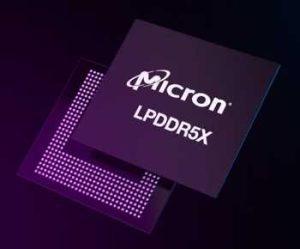Micron Low-Power Memory Solution Boosts Mixed and VR Experiences on Qualcomm Snapdragon XR2 Gen 2 Platform
128GB UFS 3.1 and 8GB LPDDR5X qualified for Snapdragon platform available to MR ecosystem
This is a Press Release edited by StorageNewsletter.com on October 31, 2023 at 2:01 pmMicron Technology, Inc. announced that its low-power double data rate 5X LPDDR5X DRAM and UFS 3.1 embedded solutions are qualified on Qualcomm Technologies, Inc.’ extended reality (XR) platform, Snapdragon XR2 Gen 2 platform.
The LPDDR5X and UFS 3.1 deliver next-level speed, performance and low-power consumption in the smallest form factors needed to support untethered mixed reality (MR) and virtual reality (VR) devices. LPDDR5X is the firm’s advanced low-power memory, delivering power efficiency enabled by its 1-alpha process node technology and JEDEC power advancements.
The global AR and VR market is expected to reach $200 billion by 2030, growing at a CAGR of 24% from 2021.(1) The firm’s embedded products provide robust XR-ready solutions to accelerate customer adoption and realize the potential of this expanding market. Enabling concurrent processing across multiple applications and sensors, LPDDR5X and UFS 3.1 integrate constantly changing presence, position and sensory perception in the metaverse to create realistic, immersive experiences for VR users.
While the company’s LPDDR5X can achieve speeds of up to 8.533Gb/s, it is also backwards compatible for LPDDR5 speeds of 6.4Gb/s, providing device manufacturers with platform integration flexibility while consuming less power.
“The metaverse has vast potential to revolutionize how we work and play. Bringing this innovation to life requires high-performance and low-power hardware that can keep pace with the lightning-fast speeds needed for mixed reality experiences,” said Chris Jacobs, VP and GM, embedded market segments. “Our LPDDR5X and UFS 3.1 solutions are ideally positioned to serve as the foundation for the next-gen of XR devices, providing the performance and power to unlock rich virtual worlds.”
As announced on September 27, the Snapdragon XR2 Gen 2 processor was developed in close collaboration with Meta Platforms, Inc., and commercially debuted on Meta Quest 3, Meta’s newly launched headset. The Snapdragon XR2 Gen 2 Platform offers a single-chip architecture to unlock next-level immersive MR and VR experiences in thinner and more comfortable headsets that don’t require an external battery pack. Engineered to deliver a lag-free experience with breathtaking visuals and fully immersive sound, the spatial computing platform allows users to blend virtual content with their physical surroundings and transition between MR and VR experiences.
LPDDR5X provides 24% increased power efficiency compared to previous-gen (2) – optimal for untethered MR and VR headsets, extending battery life between charges for the most optimal user experience. At peak data rates of 8.53Gb/s, it enables metaverse applications with a 33% increase in data access speeds, (3) resulting in fast response times. Micron’s 1-alpha node process technology, which underpins the company’s LPDDR5X, provides higher bit density, performance and energy efficiency for XR devices.
The firm’s UFS 3.1 client storage is a world’s first UFS powered by 176-layer NAND with high storage densities in a tiny footprint – freeing up space for more design flexibility in devices such as MR and VR headsets with space constraints.
The company’s 128GB UFS 3.1 and 8GB LPDDR5X qualified for the Snapdragon platform are available to the MR ecosystem via the frm’s sales channels, distributors and partners.
(1) Prescient and Strategic Intelligence, AR and VR Market Report by Type (AR, VR), Offering (Hardware, Software), Device Type (AR Devices, VR Devices), Application (Consumer, Commercial, Enterprise) – Industry Analysis and Growth Forecast to 2030
(2) Simulated power improvement comparing full LPDDR5X speed (8.533Gb) to previous-gen PDDR5 (6.4Gb/s)
(3) Comparing peak data rates for LPDDR5X (8.533Gb/s) to previous-gen LPDDR5 (6.4Gb/s) DRAM based on published JEDEC specifications (8.533/6.4=1.33)
Resource
Blog: AR and VR, the next gen of user interface














 Subscribe to our free daily newsletter
Subscribe to our free daily newsletter

